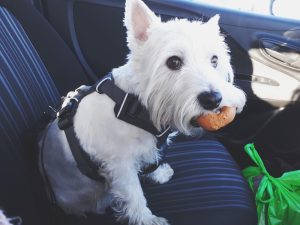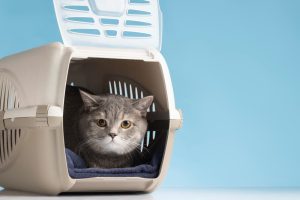Traveling with Pets by Airplane & Car [Dogs and Cats]

Updated November 16, 2025
What Factors Should I Consider When Deciding to Travel With My Pet?
Pets are part of your family, so of course, you will sometimes want them to travel with you. Whether you’re traveling by plane or car, several factors must be considered before embarking on your journey. First and foremost, evaluate your pet’s temperament and behavior. Is your furry companion calm and well-behaved, or do they tend to be anxious or disruptive in unfamiliar environments? This may even help you determine the best mode of transportation and whether your pet will be comfortable during the trip.
Next, consider your pet’s age, health, and any special needs they may have. Older pets or those with medical conditions may require additional considerations, such as the ability to access veterinary care or the need for specialized accommodations. It’s also crucial to ensure your pet is up-to-date on all necessary vaccinations and preventative care before travel.
Finally, research the specific requirements and policies of your chosen mode of transportation, especially traveling by plane or renting a car. This will help you prepare your pet and ensure a smooth and stress-free journey for both of you.
Who Should I Contact While Considering Travel Arrangements for My Pet?
When planning a trip with your pet, it’s essential to communicate with several key contacts to ensure a successful and safe journey. Start by consulting your veterinarian. They can provide valuable guidance on your pet’s suitability for travel, recommend any necessary vaccinations or medications, and offer advice on how to minimize stress during the trip.
Next, contact your airline or car rental company to understand their specific policies and requirements for traveling with pets. Many airlines have strict guidelines, including size restrictions for in-cabin pets and requirements for pet carriers. Car rental companies may also have their own rules and fees for transporting pets.
If you’re planning to stay at a hotel or other accommodations during your trip, be sure to contact them as well. Many establishments have pet-friendly policies, but it’s always best to confirm in advance to avoid any surprises or additional fees.
Finally, consider contacting your pet’s microchip provider or registration service. They can help ensure that your pet’s identification information is up-to-date and easily accessible in an emergency.
What Essential Items Should I Bring Along on My Trip With My Pet?
When traveling with your pet, it’s essential to pack a well-stocked “pet bag” to ensure their comfort and safety throughout the journey. Start with the basics, such as:
- Leash and collar (with up-to-date identification tags showing your current contact information)
- Pet carrier or crate (appropriate for the mode of transportation and your pet’s size)
- Food and water bowls that are portable and easy to clean
- Enough food and treats for the entire trip, plus extra in case of delays
- Medications (if applicable) and a copy of your pet’s vaccination records for emergencies
- Cleaning supplies (waste bags, paper towels, stain remover for accidents)
- Comfort items, like a favorite toy, blanket, or bed that smells like home
- First aid kit including bandages, antiseptics, and any necessary medications
Additionally, consider packing a few extra items to keep your pet entertained and comfortable during the trip, such as:
- Chew toys or puzzle feeders
- Portable water dispenser
- Portable litter box (for cats)
- Cooling or heating pads (depending on the climate)
- Grooming supplies (e.g., brush, nail clippers)
How Do I Obtain a Certificate of Veterinary Inspection (Health Certificate) and Acclimation Certificate, If Required?
If you’re planning to travel with your pet by airplane, you may need to obtain a Certificate of Veterinary Inspection (also known as a health certificate) and, in some cases, an Acclimation Certificate. These documents help ensure your pet’s safety and well-being during the journey.
The Certificate of Veterinary Inspection is a document issued by a licensed veterinarian, which must be provided by a licensed veterinarian to verify your pet’s current health status and vaccination records. This certificate is typically required for air travel and for crossing state or international borders with your beloved companion. To obtain this certificate, schedule an appointment with your veterinarian a few weeks prior to your trip, as the certificate is typically valid for only 10 days from the examination date.
The Acclimation Certificate, on the other hand, is a document that confirms your pet has been acclimated to their carrier or crate and can travel comfortably without undue stress. Some airlines may require this certificate for pets traveling in the cargo hold to ensure their safety.
It’s important to note that the requirements for these certificates can vary depending on your destination and mode of transportation, so be sure to research the specific policies of your airline, car rental company, or any other transportation providers you’ll be using well in advance.
Is Obtaining an Acclimation Certificate Necessary for My Pet’s Travel?
The requirement for an Acclimation Certificate when traveling with a pet can vary depending on the airline and the mode of transportation. In general, an Acclimation Certificate is most commonly required for pets traveling in the cargo hold of an aircraft.
Airlines may request this certificate to ensure that your pet has been properly conditioned and can safely endure the changes in temperature, pressure, and noise that can occur during a flight. This helps to minimize the risk of stress, anxiety, or other health issues that could arise during the journey.
However, if your pet is small enough to travel in the aircraft cabin with you, an Acclimation Certificate may not be necessary. Many airlines have specific size and weight restrictions for in-cabin pets, and they may require a pet carrier that fits under the seat in front of you.
Research the policies and requirements of your chosen airline or transportation provider well in advance of your travel dates. This will enable you to determine if an Acclimation Certificate is required for your pet’s journey and make the necessary arrangements with your veterinarian.
Keep in mind that even if an Acclimation Certificate is not required, it’s still a good idea to familiarize your pet with their carrier and gradually acclimate them to the travel experience. This can go a long way toward ensuring a stress-free and comfortable trip for both you and your furry companion.
Can I Bring My Pet Along When Traveling Internationally?
Bringing your pet on an international trip can be more complicated than domestic travel, but it’s certainly possible with proper preparations. The key is to research your destination country’s specific requirements and restrictions well in advance.
When traveling abroad with your pet, you may face unique challenges such as securing travel assistance services and emergency support for your pet in a foreign country where language barriers exist.
Many countries have strict regulations regarding the importation of animals, including mandatory quarantine periods that can last weeks or months, vaccination requirements that differ from U.S. standards, and the need for specific documentation that must be obtained in advance. Some countries may even prohibit the entry of certain breeds or species of pets,
To ensure a smooth international journey with your pet, start by contacting the embassy or consulate of your destination country to understand their pet import policies. You’ll likely need to obtain an international health certificate, any required vaccinations, and microchip identification. Depending on the country, you may also need to provide proof of rabies vaccination or even a rabies titer test.
It’s important to note that the logistics and costs of international pet travel can be quite complex, so be prepared to invest time and resources into the process. Additionally, consider the potential stress and discomfort your pet may experience during long flights or extended periods of travel.
If you’re unsure about the feasibility of bringing your pet on an international trip, consult with your veterinarian and a reputable pet travel agency to weigh the pros and cons and determine the best course of action.
Can I Bring My Pet On Camping Trips?
Bringing your pet along on a camping trip can be a wonderful way to include them in your outdoor adventures, but planning ahead and considering their needs is essential for their safety. Before embarking on your camping excursion, ensure your pet is comfortable and well-behaved in outdoor settings, as the sights, sounds, and smells of a campground can be overwhelming for some animals.
When packing for your camping trip, include all the necessary supplies for your pet, such as a sturdy leash, a portable water and food bowl, and any medications or special dietary requirements. It’s also a good idea to bring along a cozy pet bed or blanket to help your furry companion feel at home in the great outdoors.
Be mindful of your pet’s safety and well-being during your camping trip. Keep your pet on a leash at all times to prevent wandering off or encountering potential dangers, such as wildlife or hazardous plants. Additionally, be prepared to clean up after your pet and dispose of any waste properly to maintain the cleanliness and eco-friendliness of the campsite.
If your pet is not accustomed to camping or you have concerns about their ability to adapt to the outdoor environment, it may be best to leave them in the care of a trusted friend, family member, or pet sitter. The safety and comfort of your pet should be your top priority when considering a camping trip.
Car Travel With Pets
Use Pet Carriers
When traveling by car with your pet, a secure pet carrier or crate is essential for their safety. A well-designed carrier will keep your pet contained and provide a comfortable and familiar space for them during the journey, reducing anxiety.
Select a carrier suitable for your pet’s size and weight, and ensure it is properly secured in the vehicle, either in the back seat or the cargo area. This will prevent your pet from becoming a distraction while you’re driving or from being injured in the event of a sudden stop or accident.
Remember to introduce your pet to the carrier well in advance of your trip, allowing them to become accustomed to it. Placing familiar bedding, toys, or treats inside can also help your pet feel more at ease during the car ride.
Use Seat Belts
Just as you buckle up for your safety, securing your pet during car travel is important. Many pet supply stores offer specialized seat belts and harnesses to keep your furry friend safe and secure in a collision or sudden stop.
Attach the seat belt or harness to your pet’s collar or harness, ensuring a snug but comfortable fit. This will prevent your pet from being thrown around the vehicle or escaping the car in the event of an accident.
Always keep your pet in the back seat, as the front passenger airbag can be hazardous for animals. Additionally, never allow your pet to ride in your lap or hang out the window, as these positions can be extremely hazardous.
Consider Using Zipline for Active Dogs
For more active dogs who may have a tendency to move around the car, a zipline system can be a great option to keep them safely contained while still allowing them some freedom of movement.
A zipline is a tether that attaches to the car’s frame and allows your dog to move back and forth between the rear and front seats without the risk of jumping out or becoming a distraction to the driver.
When using a zipline, be sure to choose one that is the appropriate length for your vehicle and your dog’s size and weight. Adjust the tether to provide enough slack for your pet to move comfortably, but not so much that they could become entangled or leap out of the car.
Consider Using a Seat Hammock
Another innovative solution for keeping your pet secure and comfortable during car travel is a seat hammock. These specialized products are designed to create a cozy, enclosed space for your pet in the backseat while still allowing them to see out the windows.
Seat hammocks are typically made of durable, machine-washable fabrics and attach securely to your vehicle’s headrests or seat anchors. They keep your pet contained and protect your car’s upholstery from potential scratches, shedding, or accidents that could damage the interior.
When selecting a seat hammock, look for one that is the appropriate size for your pet and offers features like padded sides, storage pockets, and easy-access entry points. This will ensure your furry companion remains comfortable and secure throughout the journey.
Plan For Regular Breaks
Whether you’re traveling by car or airplane, planning for regular breaks is essential to allow your pet to stretch its legs, relieve itself, and hydrate and refuel.
When driving, aim to stop every few hours to allow your pet to get out of the car and explore a safe, enclosed area. This helps them burn off energy and reduces the risk of motion sickness or other travel-related discomfort.
During these breaks, be sure to keep your pet on a leash and provide access to clean water and waste disposal bags. You may also want to bring along a portable pet bowl or mat to ensure your furry friend has a designated spot to eat and drink.
Remember, the frequency and duration of these breaks will depend on your pet’s age, size, and individual needs. Pay close attention to your pet’s behavior and adjust your schedule accordingly to ensure their comfort and well-being throughout the trip.
Air Travel With Pets
How Can I Select the Most Suitable Flights for My Pet’s Needs?
When booking flights for travel with your pet, carefully consider the timing and duration of the flights to ensure your furry companion’s comfort and safety.
First and foremost, try to book direct flights whenever possible to minimize stress. This will reduce the amount of time your pet spends in the aircraft’s cargo hold or cabin. Layovers and connecting flights can be stressful and disruptive for pets, increasing the risk of delays, mishaps, or your pet being mishandled.
Additionally, aim to book flights during the cooler hours of the day, as extreme temperatures in the cargo hold can be dangerous for your pet. Early morning or late evening flights may be preferable, depending on the climate of your destination.
It’s also a good idea to inquire about the airline’s policies regarding the number of pet travelers per flight and any restrictions on the size or breed of animals allowed. This will help you determine the most suitable options for your pet.
Finally, be sure to communicate any special needs or concerns about your pet’s travel to the airline representatives when booking your tickets. This will ensure they are well-informed and can provide the necessary accommodations or assistance during the journey.
What Steps Should I Take on the Day of My Pet’s Flight?
On the day of your pet’s flight, there are several important steps to take to ensure a smooth and stress-free experience:
- Arrive at the airport early: Plan to arrive at least 2 hours before your scheduled departure time to allow ample time for check-in, security, and any additional pet-related procedures that may be required.
- Exercise your pet: Take your furry companion for a brisk walk or playtime before their flight to help them burn off excess energy and feel more relaxed during the journey ahead.
- Withhold food and water: It’s best to withhold food and water from your pet for several hours before the flight to prevent motion sickness or accidents during the journey. However, consult your veterinarian for specific timing.
- Familiarize your pet with the carrier: Make sure your pet is comfortable and familiar with the carrier they’ll be traveling in. Introduce them to it well in advance and use positive reinforcement to create a positive association with the space.
- Communicate with airline staff: Inform the airline staff at check-in about your pet’s presence and any special needs or requirements they may have. If you are traveling with a service animal, notify the airline staff so they can provide the proper accommodations for your service animal.
- Provide identification and documentation: Ensure your pet’s collar or harness has up-to-date identification tags, and have their health certificate and any other required documents readily available for inspection.
- Comfort your pet: During boarding, offer your pet reassurance and comfort through your calm demeanor, and avoid prolonged goodbyes that could cause additional stress and anxiety.
Should I Tranquilize or Sedate My Pet During Long Flights?
The decision to tranquilize or sedate your pet during long flights is complex and requires careful consideration, as well as consultation with your veterinarian.
On one hand, sedatives can help some pets cope with the stress and anxiety of air travel, particularly during extended flight times or when traveling in the cargo hold. Sedation can reduce the risk of behavioral issues, such as excessive vocalizations or attempts to escape the carrier, which could potentially endanger the animal or disrupt other passengers.
However, the use of sedatives also comes with potential risks. Certain medications can have adverse effects on your pet’s respiratory system or cause other health complications, especially when combined with changes in air pressure and oxygen levels at high altitudes.
Which Crates Are Approved for Air Travel?
When traveling by air with your pet, use an airline-approved crate or carrier. These specialized containers are designed to provide a secure and comfortable environment for your furry companion during the flight.
The specific crate requirements can vary by airline, so it’s essential to research and comply with the regulations of your chosen carrier. In general, approved crates must be made of rigid plastic or hard-sided materials, with adequate ventilation on multiple sides. Soft-sided carriers may also be permitted for in-cabin travel as long as they fit under the seat in front of you.
Regardless of the type of crate, it should be large enough for your pet to stand, turn around, and lie down comfortably, but not so spacious that they can be thrown around during turbulence. Many airlines also have size and weight restrictions, so be sure to measure your pet and the carrier before booking your travel.
It’s a good idea to introduce your pet to their crate well in advance of the trip, allowing them to become accustomed to the space and feel secure inside. You can also place familiar bedding, toys, or treats within the crate to help your furry friend feel at ease during the journey.
Your pet’s safety and well-being should be your top priority when selecting a crate for air travel. By choosing the right container and adhering to the airline’s guidelines, you can help ensure a stress-free and comfortable experience for your beloved companion.
Air Travel with Pets FAQs:
What Airlines Allow Dogs in Cargo?
Many major airlines, including American Airlines, Delta, United, and Southwest, allow dogs and cats to travel in the cargo hold, subject to certain size and weight restrictions. Before booking your flight, it’s essential to check with your airline for their specific policies and requirements.
What Size Dogs Are Allowed on Planes?
The size and weight of your dog will determine whether they can travel in the cabin or in the cargo hold. Most airlines have a weight limit of 15-20 pounds for in-cabin pets, while larger dogs must travel in the cargo hold. It’s important to verify the size and weight restrictions with your airline well in advance of your travel dates.
What Do I Need to Travel with My Dog Internationally?
Traveling with a pet internationally requires additional documentation and preparation. This typically includes a valid health certificate, up-to-date vaccinations, and potentially a microchip or other identification. Be sure to research the entry requirements for your destination country and plan accordingly.
What Can I Give My Dog Before Flying?
Giving your pet any medication or sedatives before a flight is generally not recommended, as they can have unpredictable effects at high altitudes. Instead, consider natural calming aids, such as pheromone sprays or supplements, to help ease your pet’s anxiety. Consult with your veterinarian for personalized recommendations.
How Do You Take a Small Dog on a Plane?
The process is relatively straightforward for small dogs that can fit in an approved carrier under the seat in front of you. Be sure to check with your airline for their specific in-cabin pet policies, as some may restrict the number of pets allowed per flight. Additionally, you’ll need to ensure your pet’s carrier fits the required dimensions and can be stowed safely during takeoff and landing.
Can I Hold My Dog During Takeoff?
No, holding your dog during takeoff or landing is not permitted. Your pet must remain in its approved carrier, either under the seat in front of you or in the cargo hold, for the entire flight. This is for the safety of both your pet and the other passengers on board.
How Do You Book a Flight with a Dog?
When booking your flight, notify the airline that you will be traveling with a pet. This will ensure they can accommodate your furry companion and provide any necessary guidance or instructions. You’ll typically need to pay an additional pet fee, which can vary depending on the airline and the size of your pet.
Can Dogs Walk on a Leash Through an Airport?
Most airports permit dogs to be walked on a leash through the terminal, provided they are properly contained and controlled. However, it’s important to be mindful of other passengers and to keep your pet close to you, especially in high-traffic areas. Some airports may have designated pet relief areas or walking zones; therefore, be sure to research the policies of both your departure and arrival airports.
Can I Refuse to Sit Next to a Dog on a Plane?
If you have a severe allergy to dogs or a phobia of them, you may be able to request a different seating assignment. However, airlines generally try to accommodate passengers with pets and allergies or concerns. It’s best to communicate your needs to the airline in advance to see if they can find a suitable solution.
How Do Dogs Go Through Airport Security?
When passing through airport security, your dog will need to be removed from their carrier and walk through the metal detector or body scanner. The carrier will need to be X-rayed separately. Be prepared to hold your pet or have them walk through the security checkpoint on a leash.
Do Pets Fly Free on Any Airline?
No, all airlines charge a pet fee, which can range from $100 to $200 or more, depending on the size of your pet and whether they are traveling in the cabin or in the cargo hold.
Is There an Airline Just for Pets?
While there are no airlines dedicated solely to transporting pets, some companies, such as Pet Airways, have specialized in providing pet-friendly air travel services. Some companies also offer travel assistance services to help coordinate pet transportation and care, ensuring pets receive support such as emergency vet access or boarding arrangements during travel for your peace of mind. These specialized services often have additional amenities and staff trained to care for animals during the flight.
Can a 10kg Dog Travel on a Plane?
The answer to this question depends on the airline’s specific policies and restrictions. Many airlines have a weight limit of 15-20 pounds (7-9 kg) for in-cabin pets, while larger dogs may be required to travel in the cargo hold. It’s essential to check with your airline to ensure your 10kg dog can be accommodated, either in the cabin or in the cargo hold, and to understand any additional requirements or fees.
Train, Ship, or Bus Travel With Your Pet
While car or air travel may be the most convenient option for some pet owners, it’s not the only way to travel with your furry friend. Trains, ships, and buses can also be viable options, each with its own unique considerations.
When it comes to train travel, many rail companies now allow pets on board, though the specific policies can vary greatly. Some may require your pet to be kept in a carrier at all times, while others may allow them to roam freely (within reason) during the journey. Make sure to research the rules and regulations of your chosen rail provider before booking your tickets.
Similarly, some cruise lines and ferry operators welcome pets on board, though the amenities and accommodations can differ significantly. Certain ships may offer dedicated pet-friendly areas, while others may have more limited options. Inquiring about the specific pet policies and any additional fees or requirements is crucial before setting sail.
Bus travel can also be a viable option for pet owners, though the policies can be even more varied than those of trains and ships. Some bus companies may allow small pets in carriers, while others may have a strict “no pets” policy. It’s essential to check with your chosen bus line to understand their regulations and make the necessary arrangements.
How Does Having Pet Insurance Help You While Traveling with Your Dog or Cat
Traveling with pets can be unpredictable, and unexpected medical emergencies or accidents can occur. This is where pet insurance can be invaluable. Having a comprehensive pet insurance policy, you can enjoy greater peace of mind and financial protection during your travels.
What Does Odie Pet Insurance Cover?
Pet insurance covers various veterinary expenses, providing financial protection and peace of mind for pet owners. Here are the details of the coverage options offered by Odie Pet Insurance:
Illness & Injury Plan
The Illness & Injury Plan is an all-inclusive insurance plan designed to cover a wide range of medical needs for your pet. This plan includes comprehensive coverage for various illnesses, injuries, and veterinary services. Some of the covered items include:
- Veterinary exams and consultations
- Diagnostics (e.g., X-rays, lab tests)
- Prescribed medications
- Surgeries and hospitalization
- Rehabilitation, acupuncture, or chiropractic treatments
- Medically necessary supplies
- Euthanasia and cremation
The Wellness Plan
The Wellness Plan is a monthly membership that focuses on preventive care and covers routine veterinary services.
- Provides reimbursements for routine care items such as wellness visits (exams and vaccines), testing and parasite prevention, dental cleanings and at-home dental care, vitamins, supplements, and more.
- Through Odie’s partnership with Petivity, a leader in smart pet products and proactive care, Wellness Plan members can also receive reimbursements for Petivity devices and health kits, as well as eligible Purina food and supplements.
- Total reimbursement up to $700 per year.






